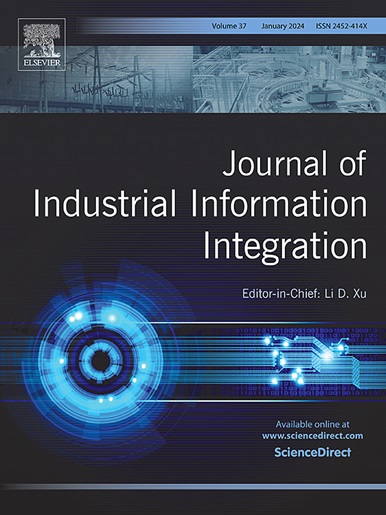在 AGV 导航中将物联网传感器与基于到达角的角度测量相结合:可靠性研究
IF 10.4
1区 计算机科学
Q1 COMPUTER SCIENCE, INTERDISCIPLINARY APPLICATIONS
引用次数: 0
摘要
自动导引车(AGV)最初是为工业领域的室内作业而设计的,现在已越来越多地应用于户外重型物流任务。在典型的导航任务中,例如自主跟踪指定物体或人员,需要 AGV 与目标之间的相对角度和相对距离。为了获得必要的信息,各种车载传感器被广泛集成。本文研究了德州仪器(TI)和 u-blox 两种不同的物联网(IoT)传感器组根据蓝牙 5.1 采用到达角(AoA)方法测量相对角度的可靠性。通过角度精度参数和接收信号强度指示器(RSSI)验证了物联网传感器的性能。然后将性能较好的物联网传感器集成到 AGV 导航系统中,通过物联网传感器收集的信息,AGV 可以转向目标方向。基于物联网传感器信息的 AGV 转向目标方向的过程分别在模拟和实际环境中进行了测试,并通过实际相对角度与 AGV 旋转角度之间的差距进行了评估。结果表明,在模拟和实际环境中,这一差距都在±5°以内,并提出了更高精度的方法。通过这种方式,系统地评估了到达角(AoA)传感器在测量相对角度方面的可靠性和性能(其他研究人员尚未对此进行探索),从而有助于扩大 AoA 传感器在复杂的实际应用中的可用性。本文章由计算机程序翻译,如有差异,请以英文原文为准。
Integration of an IoT sensor with angle-of-arrival-based angle measurement in AGV navigation: A reliability study
Automated guided vehicle (AGV), which was initially designed for indoor operations in industry, has been increasingly applied in outdoor heavy-duty logistics tasks. In typical navigation tasks, such as the autonomous tracking of a designated object or a person, relative angle and relative distance between AGV and the target is required. To obtain the necessary information, various on-board sensors are extensively integrated. In this paper, the reliability of measuring the relative angle with the Angle-of-Arrival (AoA) method with two different Internet of Things (IoT) sensor sets from Texas Instrument (TI) and u-blox, according to Bluetooth 5.1 was investigated. The performance of IoT sensors was validated with angle accuracy parameters and received signal strength indicator (RSSI). The better IoT sensor was then integrated into the AGV navigation system, and the information gathered from IoT sensor enabled the AGV to turn toward the direction of the target. The process of AGV turning to the targeted direction based on IoT sensor information was respectively tested in the simulation and actual environment and evaluated by the disparity between the real relative angle and the rotation angle of the AGV. The results showed that this disparity was within ±5° in both simulated and actual environments, and methods for higher accuracy were proposed. In this way, the reliability and performance of Angle of Arrival (AoA) sensors in measuring the relative angle, which remains unexplored by other researchers, was systematically assessed contributing to extending the usability of AoA sensors in complex, real-world applications.
求助全文
通过发布文献求助,成功后即可免费获取论文全文。
去求助
来源期刊

Journal of Industrial Information Integration
Decision Sciences-Information Systems and Management
CiteScore
22.30
自引率
13.40%
发文量
100
期刊介绍:
The Journal of Industrial Information Integration focuses on the industry's transition towards industrial integration and informatization, covering not only hardware and software but also information integration. It serves as a platform for promoting advances in industrial information integration, addressing challenges, issues, and solutions in an interdisciplinary forum for researchers, practitioners, and policy makers.
The Journal of Industrial Information Integration welcomes papers on foundational, technical, and practical aspects of industrial information integration, emphasizing the complex and cross-disciplinary topics that arise in industrial integration. Techniques from mathematical science, computer science, computer engineering, electrical and electronic engineering, manufacturing engineering, and engineering management are crucial in this context.
 求助内容:
求助内容: 应助结果提醒方式:
应助结果提醒方式:


